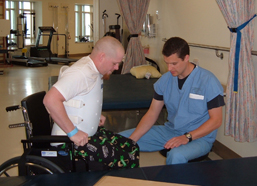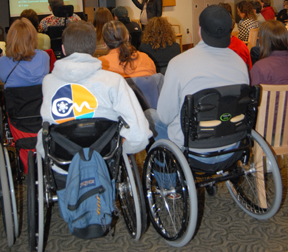Spinal Cord Injury Model Systems Consumer Information
Pain after Spinal Cord Injury
SUPPLEMENT: Activity Modification for
Musculoskeletal Pain
[Click here for a printer-friendly version of this page.]
On this page:
Exercise
- Almost everyone can benefit from a fitness program that includes resistance training of the muscles that stabilize the shoulder. This will help prevent shoulder pain from occurring as well as treat overuse pain. Strong muscles are much less likely to be injured. Talk with your doctor or therapist about starting a program of resistance exercises that emphasizes those muscles that are often neglected during
- For cardiovascular exercise, use upper limb ergometry equipment, such as a stationary bicycle powered by the arms, or a hand-cranked sports wheelchair. You can also box with a speed-bag instead of pushing a manual wheelchair for exercise. Such equipment will reduce stress on the shoulders and wrists.
- Make sure your back and shoulder muscles are strong enough to support wheeling and transferring. It is especially important that there is a balance between your left and right sides. Ask your physical therapist to evaluate you and to prescribe strengthening exercises if you need them.
Using a Wheelchair
- Repetitive pushing of wheel rims is a major problem activity causing musculoskeletal pain. Consider obtaining a power or power-assist wheelchair if you:
- Have significant upper limb (shoulder, elbow or hand) pain.
- Have tetraplegia (quadriplegia).
- Have a prior injury to an upper limb.
- Are overweight.
- Are elderly.
- Live in a challenging environment such as on a steep hill or near very rough terrain.
- If you use a manual wheelchair, make sure it is the lightest model (made from aluminum or titanium) you can afford or your insurer will pay for. Lighter models give you less weight to push around and can often be customized to make it easier for you to propel the chair
- If you do use a manual wheelchair, reduce the number of strokes you use per distance traveled. Rather than quick short pushes, use long smooth strokes.
- If you use a manual wheelchair, make sure it is in good repair and set up in a way that allows you to get around with minimal effort. Ask your therapist to check whether your seat is in the right position relative to your rear axle. Also have him/her check that the chair and cushion together give you good stability.
- Get your wheelchair seating, posture and pushing technique evaluated by a rehab professional periodically since your needs, habits or activities may change over time.
- Keep your tires well-inflated to minimize rolling resistance.
- Wheel your chair over concrete and linoleum rather than through sand, grass or heavy carpeting. The reduced resistance to your wheels lessens the load on your arms.
Shoulder Health
- Minimize the frequency of arm/hand tasks, especially tasks that involve lifting heavy loads higher than your shoulder. Let someone else get that book off a high shelf for you.
- If possible, do not do tasks repetitively that require you to bring your hand higher than your shoulder. This may require reorganizing your house. Talk with your occupational therapist about ways to do so.
- Minimize lifting heavy loads. If you cannot get someone else to do the heavy lifting, hold whatever you need close to your chest rather than at the end of an outstretched arm.
- Avoid doing push-up pressure reliefs (weight shifts), which can harm your shoulder joint. Instead, perform side-to-side or forward-lean pressure reliefs. Work with a therapist to learn proper technique for these methods or see the MSKTC fact sheet “How to do Pressure Reliefs (Weight Shifts)” before discontinuing push-ups.
Transfers
- The heaviest thing you lift generally will be yourself. Reduce the number of transfers you do each day, and do them in a way that minimizes risk of injury.
- Transferring from a high point to a lower one is not as hard on your wrists, elbows and shoulders as transferring from a low to a higher point. It is better to make two level transfers rather than one downhill transfer followed by one uphill transfer.
- Use sliding boards and other assistive devices (such as lifts) in making transfers.
- When transferring, use a handgrip if available, rather than putting your hand on a flat surface.
- When transferring, don’t spread your hand flat and rest on it. Make a fist, and rest on your knuckles.
- When transferring, position your hands as closely to your body as possible so that your arms are straight up and down and your weight hangs between them.
- Alternate which one of your arms is the lead arm in transferring. Different muscles are used by the lead and trailing arms during transfers, and alternating the arms keeps muscles balanced.
- Maintain your ideal weight. Being overweight is hard on your shoulders, arms and wrists when you do transfers or push your wheelchair.
Reference
Consortium for Spinal Cord Medicine. Preservation of upper limb function following spinal cord injury: a clinical practice guideline for health-care professionals. J Spinal Cord Med 2005;28:433-70.
Author and copyright information
Pain after Spinal Cord Injury: SUPPLEMENT: Activity Modification for Musculoskeletal Pain was developed by J. Scott Richards, PhD, Trevor Dyson-Hudson, MD, Thomas N. Bryce, MD, and Anthony Chiodo, MD, in collaboration with the Model Systems Knowledge Translation Center (http://msktc. washington.edu) with funding from the National Institute on Disability and Rehabilitation Research in the U.S. Department of Education, grant no. H133A060070.
MSKTC consumer health information content is based on research evidence and/or professional consensus and has been reviewed and approved by an editorial team of experts from the SCI Model Systems.
©2009 Model Systems Knowledge Translation Center (MSKTC).






